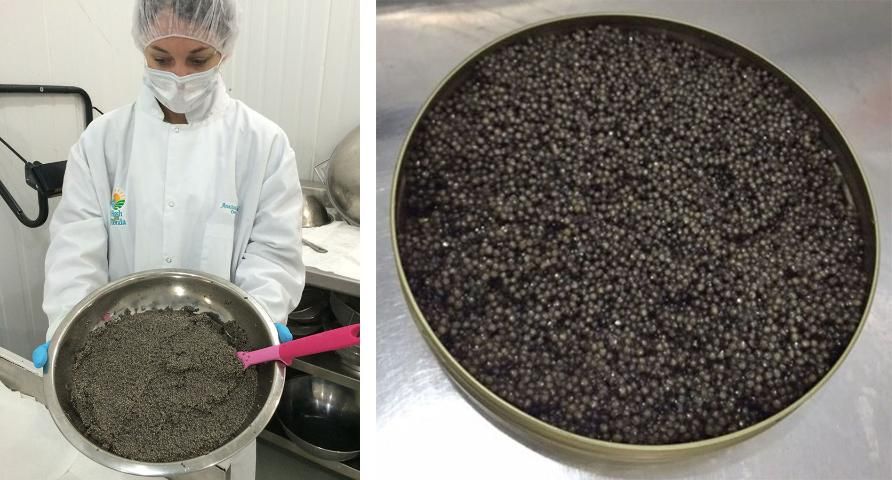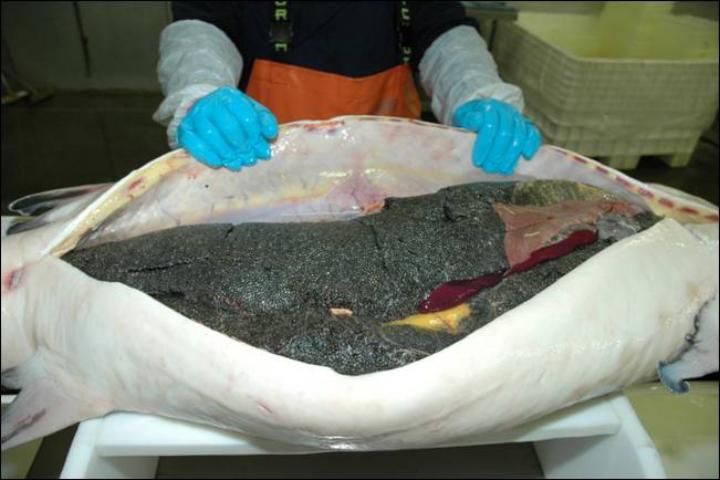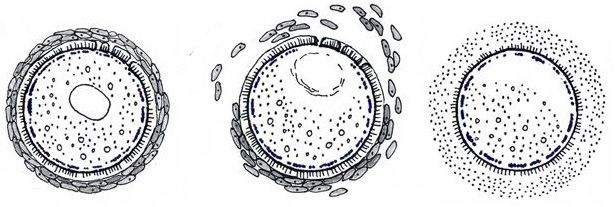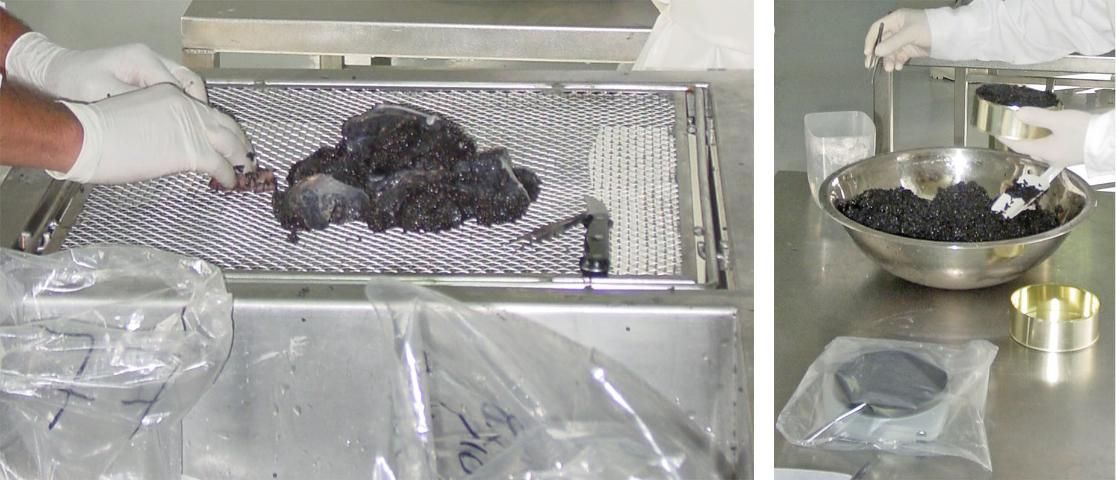The eggs of all kind of fishes and shellfish are eaten in most parts of the world and are among the most valuable of fishery commodities because they are considered a delicacy and sell for a high price. The eggs can be eaten as whole roe, (the eggs still attached to the ovary, like from the mullet fish, which is often called "bottarga"), or as individual eggs that may be collected directly from where the female deposits or spawns her eggs (e.g., "tobiko", from flying fish), or by harvesting the female and separating the eggs from the ovary (e.g., salmon, lumpfish, and sturgeon "caviar").
The most sought-after and high-valued of seafood roes are the eggs obtained from the sturgeon fish. Traditionally, sturgeon eggs have been cured by lightly salting them. They are sold as caviar, a word derived from the Turkish word "havyar." Traditionally coveted by royalty and the aristocracy, sturgeon caviar today is prized by chefs and discerning food connoisseurs the world over for its delicate flavor and nutrient-rich health benefits (Figure 1).

Credit: Evans Farm
This fact sheet highlights sturgeon caviar and some structural features of the eggs that directly impact caviar quality. Answering the question "what is sturgeon caviar?" will help the consumer differentiate between the principal types of sturgeon caviar available in the marketplace, especially when paying a high price for a certain species or grade of caviar, or a label or brand. But most important is to maintain consumer confidence in the high quality of sturgeon caviar processed using a traditional and time-honored method—and to ensure new customers in the process.
Sturgeon Caviar and Caviar Substitutes
The traditional sources of sturgeon caviar were the natural stocks of sturgeon principally from the Caspian Sea. Because of the high value of sturgeon as food (meat and caviar) in combination with their complex life cycle (sturgeon live for decades and mature late, in their 20s or even 30s) and the ease with which the fish are captured when they are migrating to spawn, the history of sturgeon has been one of over-exploitation and depletion. Populations once numbering in the hundreds of thousands at the turn of the 1900s are now listed as threatened or in danger of extinction. Sturgeon have been protected by many countries and in international commerce through CITES (the Convention on International Trade in Endangered Species of wild fauna and flora).
The high demand for sturgeon caviar in conjunction with a scarce supply of sturgeon from the fishery resource has resulted in a wide variety of products developed from other fish species to imitate or act as a substitute for sturgeon caviar. Even granulated products made from algae, fish, and plant products are made to emulate caviar from sturgeon.
Caviar's reputation as a high-quality product coupled with high demand and limited supplies for sturgeon caviar have led to food regulations in the United States requiring that only the eggs from sturgeon and paddlefish may be marketed with simply the word "caviar" on the package label. All other eggs or caviar substitutes must be labeled identifying the species from which the eggs were obtained, like lumpfish caviar, capelin caviar, flying-fish caviar, whitefish caviar, or salmon caviar. Product expectations, the price, and other attributes of the different types of "caviar" are a reflection of their origin, their quality or grade, and the species of fish producing them.
The Sturgeon Female Ovary
The ovaries in sturgeons are two paired organs that contain assemblies of individual eggs held together in a matrix of connective tissue called the skein. The entire mass of eggs including the skein is called roe. The ovaries of mature females that are marketed for roe typically can make up between 10% to 30% of their total body weight. Inside the body cavity, the ovary is attached to the dorsal wall and the eggs, held in the skein, hang down loosely in the body cavity like a bunch of grapes growing and ripening on a vine (Figure 2).

Credit: Dr. Fred S. Conte
Before spawning, the eggs (or ova) produced in the ovaries must grow and ripen. Each egg is encircled by a blanket of specialized cells called the follicular cell layer that directly nourishes the egg (Figure 3). The process of egg growth and ripening (maturation) may be quite prolonged and last from many months to several years. During the maturation period, the eggs accumulate large amounts of yolk that will eventually feed the embryo during development through hatch and until the larvae start eating exogenous food. As the eggs complete yolk deposition, they become pigmented (shades of brown, grey, and black) and reach a maximum size (typically 2.8 to 4.2 mm). The size of a sturgeon egg depends partly on the species and partly on heredity, age, and diet. The eggs are single cells, each with a nucleus that contains its hereditary material (DNA) and coordinates functions for its own maintenance, growth, and reproduction (cell division). During the prolonged period of egg growth, the nucleus is positioned in the center of the egg. As the egg approaches its final ripening process, the nucleus migrates to the tip, called the animal pole, of the slightly oval shaped mature egg, to help the genetic material of the egg mix easily with that of the sperm during fertilization. Once the eggs ripen, they break loose both from their surrounding follicular layer and the skein, in a process called ovulation. The freed (ovulated) eggs can now flow down specialized tubes (paramesonephric or müllerian ducts) and be released outside of the body cavity (spawning) and fertilized to give rise to a new organism. The "naked" ovulated egg (without the follicular layer) is covered by a shell (chorion) that, when exposed to water, will swell and water-harden to protect the embryo inside so that it can complete its development. Also, a type of jelly is released from the chorion that allows the eggs to stick to substrate on the river-bed (Figure 3).

Credit: UF/IFAS Extension
The Egg for Making Caviar
In the traditional method for making caviar, the ovaries are collected by harvesting the female and removing the individual eggs from the surrounding membranes. The ovary is carefully cut into pieces so that handfuls of eggs may be gently rubbed over stainless steel screens and the individual eggs separated from the ovary fall into a container below. The lose eggs are cleaned (rinsed several times in chilled clean water), graded, and preserved using dry-salts. Premium caviar is customarily packed in tin cans and glass jars (Figure 4).

Credit: Esturiones del Río Negro and Ricardo Armelin
In scientific terms, an egg that is still surrounded by the follicular layer and attached to the skein is referred to an oocyte. Only after it ripens and is released from the follicle is it called an egg (ovum, or ova when plural). Therefore, when the eggs are separated from the skein and used for making traditional sturgeon caviar they are technically oocytes (not true eggs), still with the intact follicular layers surrounding each egg and attaching it to the ovarian membranes (see Figure 3). The follicular layers, together with the egg membrane, are what give traditional sturgeon caviar its unique sensory attributes, especially firmness, texture and dissolvability. The appearance (color, gloss, and hue) of the eggs is also greatly influenced because they are still encased by layers of follicular cells that, although almost transparent, will still reflect and absorb light. Also, as the oocytes become fully ripened (just before being ovulated) they swell slightly and become soft, as their yolks and other internal organelles are shifted around to prepare for ovulation and fertilization. In addition, the eggs increase slightly in size and turn from round to oval in shape.
Although caviar flavor is typically enhanced with salt, it is greatly influenced by what the female eats and what type of water the female lives in during her lifetime. Flavors can also be altered as the egg gains or loses water, depending if it is still encased by the follicular cell layer or not during the caviar preparation process. Traditional premium sturgeon caviar of the highest quality and flavor is the type prepared with eggs still surrounded by the follicular cells, eggs (oocytes) that have achieved their maximum size, acquired the familiar appearance and texture, and just beginning to ripen. If the eggs are immature they will be smaller and will not yet have attained their full coloration. If they eggs are too old, they will have begun absorption of their yolks, losing their turgidity (greatly becoming softer) and becoming irregular in shape. The quality of immature and over-mature eggs is compromised, and the product is far less appealing and valuable.
Categories of Sturgeon Caviar
There are currently four major commercial categories of sturgeon caviar, all of which can vary in quality and sensory attributes (which also affect their prices). The first and most popular is the traditional malossol caviar, which means lightly salted (3–4% salt). The process, very briefly, involves separating the eggs from the skein using a stainless steel screen or sieve, rinsing and cleaning the eggs, adding salt, draining excess water, placing them in some sort of container with proper storage and handling at 0 to -3 °C. Salt is the only addition allowed by the FDA in the US product, but in some other countries, borax is added as a preservative. A second category is salted caviar (10–12%), which is prepared using the same process but with a higher salt content for a longer shelf-life. The third type of caviar is pressed caviar, which is usually made from lower-quality eggs that are mixed in color or too soft, but some consumers favor it because of its concentrated taste and spreadable texture.
In traditional caviar making (and the above-described three categories of caviar), the female sturgeon must be killed to remove the large ovaries because the eggs are still surrounded by the follicular cell layer that attaches them to the ovarian membranes. Therefore, the females are harvested for both their eggs and also their meat. The meat is sold fresh, frozen, or smoked.
There is a fourth category involving a more recently developed and patented process of making ovulated egg "caviar." This product comes from females that are not killed and harvested for their meat but sustained alive during the egg harvesting process. This category or type of caviar is sometimes marketed as "no-kill caviar." The females are either given a hormone or artificially stimulated to induce them to release their eggs (ovulate). When released eggs are observed, the female is manually stripped of her ovulated eggs. Because the eggs are harvested after being ovulated (released from their follicle), they are left naked and have to be artificially treated to prevent them from swelling and water-hardening. The eggs also have to be treated to modify the egg shell and prevent the jelly coat from forming.
Sturgeon Culture
In nature, sturgeons grow slowly, and females mature late in life, typically after 15 years of age, generally because of seasonal limited food supplies and exposure to cold-water temperatures. These life history characteristics likely limited development of the industry.
Only in the late 1980s did farmers discover a method to accelerate the sturgeon life cycle under controlled conditions; farming of sturgeon has only been possible since that time, so it is a relatively new commercial enterprise worldwide. The high demand for sturgeon caviar and the innovation and availability of the new technologies have resulted in rapid growth of farm-raised sturgeon for meat and caviar.
Some websites report that aquaculturists give their sturgeon hormones to accelerate growth and maturity, but this is not true, nor is it approved by the Food and Drug Administration (FDA). Rather, using proven best management practices such as rearing sturgeon at their optimal water temperatures and feeding them every day with a nutritionally complete manufactured fish food is all that is needed to achieve accelerated growth in farm-raised sturgeon (compared to their wild counterparts). Farm-raised sturgeon females reach sexual maturity at younger ages, producing eggs when they are as young as 3 to 6 years of age, depending on the species, but are as large as their years-older wild counterparts. Today, some of the largest producers of sturgeon caviar from aquaculture are Italy, the United States, France, Russia, Germany, Uruguay, China, Bulgaria, Saudi Arabia, Romania, Israel, Hungary, and Belgium.
Concluding Remarks
The quality of caviar, which is reflected in price and acceptability, is primarily influenced by the species of sturgeon and their culture conditions, the state of ripeness of the egg, and the processing, and storage protocols used to produce the caviar. The traditional method for making sturgeon caviar uses eggs that still have an attached blanket of cells that greatly influence sturgeon caviar and give it its unique sensory attributes, especially firmness, texture, and dissolvability.
Sources of Further Information
Baker, A. K., B. Vixie, B. A. Rasco, M. Ovissipour, and C. F. Ross. 2014. "Development of a lexicon for caviar and its usefulness for determining consumer preference." Journal of Food Science 79(12): S2533–S2541.
Batista, I. 2007. "Fish roe." Pages 181–185. In: F. Shahidi, editor. Maximising the values of marine by-products. Boca Raton, Florida: CRC Press LLC.
Bledsoe, G. E., C. D. Bledsoe, and B. Rasco. 2003. "Caviar and fish roe products." Critical Reviews in Food Science and Nutrition 43(3): 317–356.
Bronzi, P., H. Rosenthal, and J. Gessner. 2011. "Global sturgeon aquaculture production: an overview." Journal of Applied Ichthyology 27: 169–175.
Carey, R. A. 2005. The philosopher fish: sturgeon, caviar and the geography of desire. Counterpoint, New York, New York.
Chapman, F. A., and J. P. Van Eenennaam. 2007. Determining the stage of sexual maturity in female sturgeon for artificial spawning. FA153. Gainesville: University of Florida Institute of Food and Agricultural Sciences. https://edis.ifas.ufl.edu/fa153
Gall, K., K. P. Reddy, and J. M. Regenstein. 2000. "Fish roe and caviar." Pages 412–416. In: R. E. Martin, E. P. Carter, G. J. Flick, and L. M. Davis, editors. Marine & Freshwater Products Handbook. Lancaster, Pennsylvania:Technomic Publishing Co.
Jarvis, N. D. 1964. Caviar and other fish roe products. U.S. Fish and Wildlife Service, Fishery Leaflet 567
Memis, D. 2014. "A short history of sturgeon caviar production in Turkey." Journal of Applied Ichthyology 30(6): 1552–1556.
Price, R. J. 1979. Fish eggs for caviar and bait. Division of Agricultural Sciences, University of California, Leaflet 21114.
Saffron, I. 2002. Caviar: the strange history and uncertain future of the world's most coveted delicacy. New York, New York: Broadway Books.
Siddique, M. A. M., J. Cosson, M. Psenicka, and O. Linhart. 2014. "A review of the structure of sturgeon egg membranes and of the associated terminology." Journal of Applied Ichthyology 30: 1246–1255.
Sternin, V., and I. Doré. 1993. Caviar – The Resource Book. Moscow: Cultura.